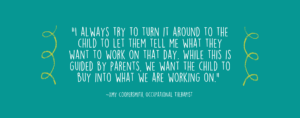Self Determination: Boost Your Child’s Success With Simple Choices
Self determination can be easy to incorporate for a child of any ability. Read this article for more info on what self determination is and how you can start providing it to your child.
The ability to make a choice can act as a life-changing catalyst for children’s development. Studies show the more children are able to lead their learning, the better they perform, said Occupational Therapist Amy Coopersmith.
“Self determination is a person’s ability to decide what they want for their own life, what will bring them joy and satisfaction and allow them to live the life that they think fits them best,” Amy said. “Especially when it comes to children, if they are not allowed to solve problems that make sense to them – it leads to alienation and learned helplessness.”
For youth, self-determination can be present in their lives in many simple ways: deciding which activities to participate in, choosing their own clothing, choosing between meal options and so forth.
One study, Amy said, involved offering children an option on which assignment to complete for their homework. The children in the intervention group were given choices about which assignment, and another group was not given a choice. The children who had the perception that they chose the assignment performed better in all areas.
“When I became an (Occupational Therapist) I began to realize that schools were not operating in that manner,” Amy said. “In particular, students with disabilities were told what to do and instructed what to do and how to go about their day.”
Amy set out to change that: “I always try to turn it around to the child to let them tell me what they want to work on that day. While this is guided by parents, we want the child to buy into what we are working on.”

Amy took bold steps to bring this change to a wider audience and launched Captain Me Kids, a video program that teaches young children all about self-determination.
“Captain Me features a puppet experiencing a problem, and during each experience he is given the opportunity to think about it, and figure out solutions that work for him,” Amy said. Within each lesson, the video pauses for the parent/teacher to talk to the kids about what the puppet did and ask them about it – what did they think the puppet could do, and what would they do if they were in that spot.
These are good exercises to help children practice self determination. Here, Amy provides a few ideas for all caregivers to offer choice-making opportunities to children and start building strong self determination foundations for all youth.
Tips to Offer Self Determination to Youth
- Make things more child led. Allowing a child to choose an assignment or make suggestions when you are trying to make a decision will help them to feel heard and provide a sense of self-worth. This type of child-led life means children will learn intrinsic motivation – being motivated internally to do something because it’s interesting or resonates personally, rather than outward motivation for something such as a simple reward like candy or a sticker, etc.
- Listen to what a child is saying and respect it. Kids are full of ideas and many of them are something you can work with to provide an activity or experience that will be positive and also resonate with the child.
Sometimes a child may not be able to communicate – so we might use a communication board to have visuals that a child can engage with to give us an idea what they are interested in. - Provide simple lists of acceptable options. This all doesn’t mean the child has full control to make decisions that are unhealthy, irresponsible and so forth. Self-determination can look like asking “should we have carrots or broccoli with dinner?” for example. As the caregiver or instructor, you can provide a simple list of acceptable choices throughout the day to increase self determination opportunities.
- Relax about things getting done perfectly. With our busy schedules and lifestyles, it can be very easy to fall into the trap of being rushed and “helping” a child to complete basic tasks that could otherwise be a good opportunity to learn independence.
“Everybody is kind of rushing to get the child off to the school,” Amy said, “and then at school they have to rush through the lessons … and the child learns to depend on everyone else to get things done for them.”
Amy suggests parents, caregivers and teachers take time to slow and relax the need for perfection in order to get the children more involved. In the morning rush example, this can look like providing the child choices the night before to get ready for the morning – like choosing their outfit and packing a lunch before bed.
—-


